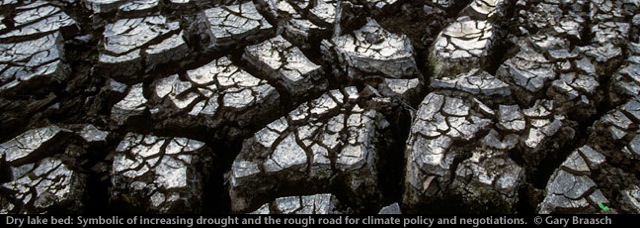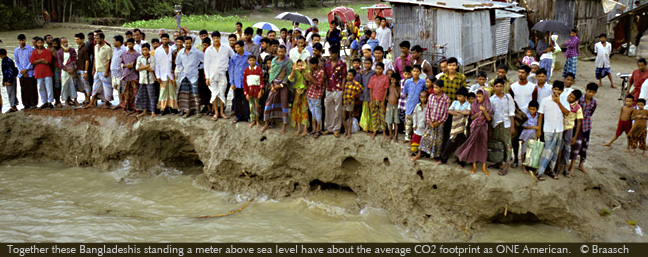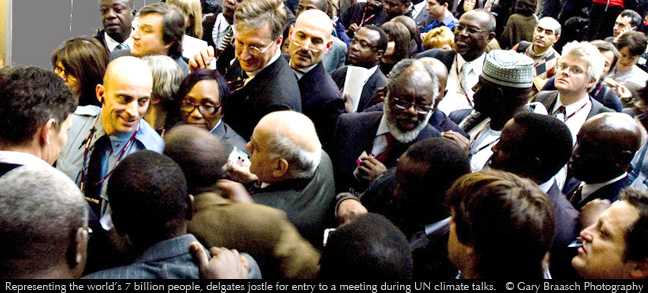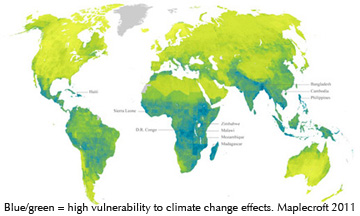Climate News and Views
December 2011
Climate progress and science findings find rough going from polluters, politics and population.

Environmental ministers and national leaders are meeting again at the UN Climate Convention negotiations amid a record deluge of greenhouse gas emissions, rapid arctic and ocean change, and mounting extreme weather events. Documented changes to the atmosphere and ecosystems are vindication of the careful science which has continued to be published showing the effects of global warming. Despite this, some corporations and politicians have managed to poison serious national climate discussion in the U.S. Although the Obama Administration is adopting a powerful increase in car fuel economy, the President does not have the promise of climate/energy solutions in his re-election platform. All but one GOP presidential candidate and many Congress members now parrot the climate denier anti-science lines that come from some conservative groups and fossil fuel industries. The American failure to take up a national program is cover for some polluting nations to remain uncommitted to emission reductions, weakens our stature and is to some an international embarrassment.
Climate avoidance, lies and hypocrisy are not only seen in the U.S. During the Durban UN climate talks, Climate Action Network analysts found that the emissions mitigation programs accepted by the UN's Clean Development Mechanism to help less-developed nations include 43 projects involving the burning of coal -- the single most polluting and poisoning fuel. Polluting nations at this year's talks in Durban are resisting going beyond the pledged Copenhagen/Cancun emissions reductions, even though those levels are not nearly enough -- the Emissions Gap -- and will cause a 4.3° C ( 7.7° F) average global temperature increase by 2100.
So far we've seen only a bit more than one degree rise, the effects of which are documented in my book Earth Under Fire: How Global Warming is Changing the World. I wrote that the changes go far beyond melting glaciers and rising seas -- to a shift in water supplies and agriculture, altered relations among nations, and promise of increased health from new energy sources. "The tools and knowledge we need to bring us a better, cooler, more humane planet are at hand right now. Our heath, security, and well-being depend on our using them."
Please read more.
In the U.S. and around the world, people who get the meaning of climate change are funding and beginning innovative action for the good of everyone's health, economic independence and the future of communities. These actions and the effect climate is having on individuals and families will be a strong focus of World View of Global Warming in 2012.

Population, poverty and international politics.
The meeting of the UN COP-17 climate talks is an excellent reminder also that our planet reached another milestone at the beginning of November when the population reached 7 billion persons according to the United Nations, that's 1 billion more people in just the last 12 years. This extraordinary rate of increase has been slowing somewhat, but by mid century estimates are there will be between 8 to 10.5 billion of us.

The distribution of this population and its wealth, health, pollution and opportunity is wildly uneven as we increasingly jostle for room and resources. Five billion of the 7 billion are Asian or African. Today, 1.3 billion people do not have electricity and 2.7 billion people still rely on the traditional use of biomass for cooking, like charcoal, dung and wood. Only 19 nations of the world's 196 countries spew out 80 percent of the global CO2 emissions, which continue to rise at record amounts. The US accounts for about 18 percent; China for 23 percent.

However, the effects of greenhouse warming of the atmosphere threaten mostly the povery-stricken, those who live in less-developed, less-polluting areas, including multi-millions of Chinese and Indians affected by their own nations' heavy emissions. In the United States, residents of low-lying coasts are seeing increasing erosion and effects from storms. This disparity and inequity is the background for the demand by the bloc of least developed nations (LDC) that developed and polluting nations control their emissions, pay into adaptation funds and agree to more stringent, legal reductions of greenhouse gases through the Kyoto Protocol and new targets. But the disparity between the science and the negotiations, like that among nations, remains huge.
Greenhouse gases increase at record rate in 2010 to highest ever recorded -- Report from Mauna Loa Observatory, Hawaii
For a view of how floodplain development and changes in land use also increase flood severity, please see Nature.
COPYRIGHT NOTICE:
Photography and text Copyright © 2005 - 2017 (and before) Gary Braasch All rights reserved. Use of photographs in any manner without permission is prohibited by US copyright law. Photography is available for license to publications and other uses. Please contact requestinformation@worldviewofglobalwarming.org. View more of Gary Braasch's photography here.


